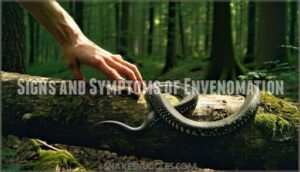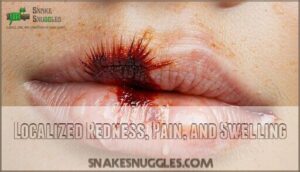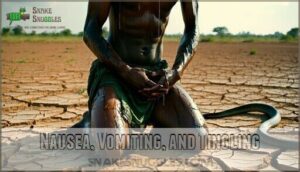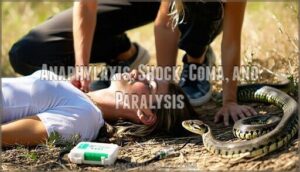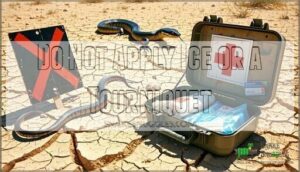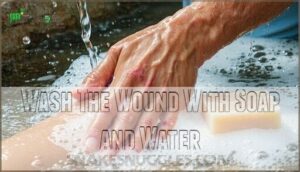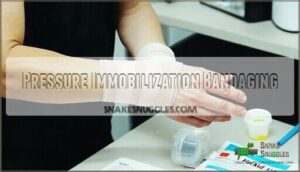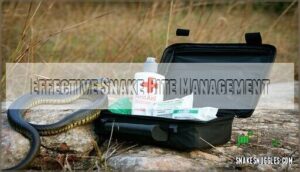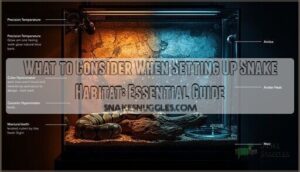This site is supported by our readers. We may earn a commission, at no cost to you, if you purchase through links.
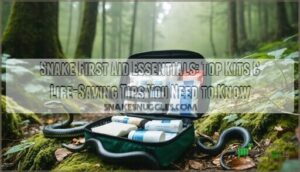
Make sure yours includes bandages, cleaning wipes, a venom extractor, and a pressure immobilization bandage—skip the tourniquet and ice, despite what old movies might suggest.
Soap and water come in handy for cleaning the wound, and quick thinking counts, so call 9-1-1 right away.
Don’t try to catch the snake for a selfie—just remember what it looked like, and with the right essentials, you can handle a snake bite like a pro, and stick around for tips that could make all the difference.
Table Of Contents
- Key Takeaways
- Identifying Snake Bites and Symptoms
- Top 4 Snake First Aid Kits
- Essential First Aid for Snake Bites
- Effective Snake Bite Management
- Frequently Asked Questions (FAQs)
- What is a snake bite first aid kit?
- What is snake bite first aid?
- Why do you need a snake bite kit?
- What should I do after a snake bite?
- How do you protect yourself from snake bites?
- What is the correct first aid treatment for a snake?
- What is given after a snake bite?
- What are the 7 principles of snake bite management?
- What is the first aid intervention for a snake bite?
- What to do immediately after a copperhead bite?
- Conclusion
Key Takeaways
- Always stay calm and call 9-1-1 immediately after a snake bite—quick action is your best defense.
- Keep a well-stocked snake bite kit with bandages, cleaning wipes, a venom extractor, and a pressure immobilization bandage—skip ice and tourniquets.
- Don’t try to catch or kill the snake; just remember what it looked like and focus on keeping the bitten limb still and below your heart.
- Wash the wound gently with soap and water, use a pressure bandage if needed, and closely monitor symptoms until help arrives.
Identifying Snake Bites and Symptoms
You never plan on meeting a snake, but knowing how to spot a bite and its symptoms can make all the difference.
If you notice swelling, pain, or odd tingling after a close encounter, it’s time to pay attention—snakes aren’t known for leaving friendly calling cards, which can indicate a serious situation.
Venomous Snakes and Bites in The United States
Regarding Venomous Species in the U.S., rattlesnakes steal the spotlight—they cause most venomous snake bites and top the Bite Statistics.
Coral snakes are rare but pack a punch. Regional Risks vary, so know your local snakes.
Prevention Tips? Stay alert outdoors, carry a snake bite kit, and remember: Antivenom Access saves lives. Snake bite first aid matters!
Approximately 8,000 occur annually in the U.S., according to the CDC, so understanding venomous snakebites is paramount.
Signs and Symptoms of Envenomation
In the context of spotting snake bite symptoms, don’t just watch the bite itself—look for systemic symptoms that can sneak up on you.
Nausea, vomiting, and tingling may signal the Envenomation Timeline is underway.
Severe cases might bring shock or paralysis, making quick action critical.
Symptom Mimicry can confuse things, so stick to Monitoring Protocols and know that Bite Severity can change fast.
Stay alert, stay safe!
Localized Redness, Pain, and Swelling
Spotting localized redness, pain, and swelling at the bite site is your first clue that things aren’t right.
That redness? It’s your body’s way of sounding the alarm. Swelling progression can be fast—don’t ignore it.
Throbbing pain is common, so focus on snake bite pain relief and keeping the area still.
Good bite site care means watching for infection risks. Keep the wound clean and dry, and remember, proper snake bite wound care helps prevent bigger problems.
Nausea, Vomiting, and Tingling
After redness and swelling, you might start to feel queasy or notice tingling in your fingers or lips. These snake bite symptoms signal the venom’s systemic effects, showing the envenomation severity is ramping up.
Here’s what to do next:
- Don’t panic—your body’s working overtime, not auditioning for a disaster movie.
- Take small sips of water; hydration importance can’t be overstated.
- Track symptom progression and any neurological impact—these details help doctors gauge treatment.
Promptly calling for snake bite emergency assistance is also critical.
Anaphylaxis, Shock, Coma, and Paralysis
If you notice sudden swelling, trouble breathing, or fainting after a snake bite, you might be facing anaphylaxis or shock—don’t wait, call 911.
Managing Shock means keeping the person warm and elevating their legs.
Coma Protocols involve monitoring breathing and clearing airways.
Paralysis Effects can sneak up, so watch for muscle weakness.
Australia has around 100 venomous snakes.
Quick action with an epinephrine injector or antivenom can save a life.
Top 4 Snake First Aid Kits
When you’re outdoors, having the right snake first aid kit can make all the difference between a close call and a medical emergency.
Let’s look at four top kits that pack serious life-saving tools—because nobody wants their next adventure to end with a hiss.
1. Venom Extractor Kit for Outdoor Emergencies
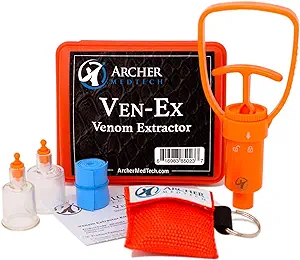
When you’re heading into snake territory, the Archer MedTech AMVENEX venom extractor kit becomes your pocket-sized insurance policy.
This one-handed design lets you operate it solo when seconds count, though remember it’s a stopgap measure, not a miracle cure.
The suction strength works best on shallow bites near the surface, so don’t expect it to handle deep muscle envenomation.
Here are five key features that make this snake bite kit stand out:
- Extractor effectiveness peaks within the first few minutes after a bite
- Kit contents include CPR shield and tourniquet band for thorough care
- Field application requires minimal training thanks to intuitive design
- Venom spread slows when suction is applied immediately to the wound
- Compact size fits easily in backpacks without adding bulk
This venom extractor won’t replace professional snake bite treatment, but it provides valuable snake bite first aid until help arrives.
Remember to also immobilize the affected area to further slow venom distribution.
The snake bite suction mechanism buys precious time in remote locations where medical assistance might be hours away.
Best For: Outdoor enthusiasts, hikers, and campers seeking compact emergency response for venomous encounters in remote areas.
2. Portable Snake Bite and Sting Kit
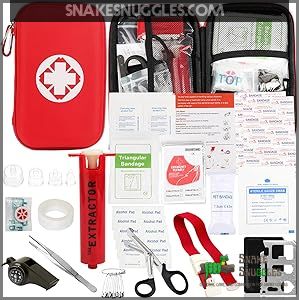
Pack this snake bite kit for your next adventure and you’ll have backup when nature gets bitey.
The Kit Contents include over 10 Emergency Items like a venom extractor, bandages, antiseptic wipes, and that handy Compass Whistle for signaling help.
The EVA Bag offers serious Kit Durability – it’s waterproof and built to survive whatever you throw at it.
This first aid kit won’t replace professional medical care, but it’s your best friend for snake bite treatment until paramedics arrive.
The compact design fits easily in your backpack without adding bulk.
Snake bite kit recommendations don’t get much better for outdoor enthusiasts who want reliable snake bite first aid gear that actually works when seconds count.
Best For: Hikers, campers, and outdoor adventurers needing compact emergency response capability.
3. Portable Venom First Aid Treatment Kit
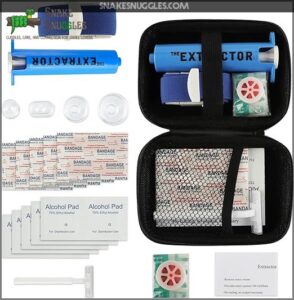
When you need something lighter than a full emergency kit, the Portable Venom First Aid Treatment Kit delivers serious protection in a compact package.
Weighing just 555 grams, this lightweight design won’t slow you down on long hikes or camping trips.
The Smart Bandage technology sets it apart from basic kits, offering advanced treatment options you can trust.
This snake bite kit includes everything for emergency treatment – venom extractors, antiseptic wipes, and detailed instructions that won’t leave you guessing.
The water resistance means your supplies stay dry whether you’re crossing streams or caught in unexpected rain.
Kit contents are organized clearly, so you’ll find what you need fast when seconds count.
Perfect for outdoor enthusiasts who want professional-grade snake bite first aid without carrying a heavy pack.
This first aid kit proves you don’t need bulk to be prepared for snake bite treatment.
4. Portable Outdoor Emergency First Aid Kit
The LIVABIT Portable Outdoor Emergency First Aid Kit proves that good things come in small packages.
This 36-piece snake bite emergency powerhouse weighs just 9 ounces but delivers serious protection when you’re miles from help. Your snake bite first aid arsenal includes a user-friendly venom extractor, disinfecting wipes, and quality bandages that’ll keep you moving.
Kit Contents highlights:
- Venom extractor designed for one-handed operation during emergencies
- Disinfecting wipes to prevent secondary infections at bite sites
- Extensive bandage selection for wound coverage and pressure application
- Compact storage bag that fits easily in backpacks or gloves compartments
Kit Portability shines here – it’s lightweight enough for day hikes yet thorough for extended trips. Kit Durability meets outdoor demands with weather-resistant materials.
While Kit Limitations include basic supplies only, this snake bite kit offers solid Kit Alternatives to bulkier options. Perfect for hikers, campers, and anyone who values preparedness without the weight penalty.
Best For: Outdoor enthusiasts engaging in hiking, camping, fishing, and backpacking activities.
Essential First Aid for Snake Bites
When a snake bites, you’ll need to act fast and stay calm, even if your heart’s racing faster than a rattler’s tail.
Knowing the right first aid steps can make all the difference before help arrives.
Call 9-1-1 Immediately
After picking out the right kit, remember: your best tool in a snake bite emergency is your phone.
Don’t wait—call 9-1-1 immediately for snake bite medical help. This gets Emergency Response and Medical Expertise moving your way for Rapid Transport and Professional Help.
When you call, follow these steps:
- Stay calm and speak clearly.
- Give your exact location.
- Describe the snake, if you can—every detail helps!
Do Not Apply Ice or a Tourniquet
After you’ve called 9-1-1, it’s tempting to grab ice or tie off the bite. Don’t do it. Ice application dangers include tissue damage and increased risk of complications. Tourniquet risks explained? They cut off blood flow, making things worse.
Forget old cowboy movies—snake bite misconceptions like sucking out venom or using constricting items are outdated. Instead, focus on effective pressure immobilization. Remember, snake bite home treatment myths linger, but only the right steps slow venom spread and keep you safer until help arrives.
A key step involves cleaning the wound with soap and water.
Myth-Busting Reality Check
Wash The Wound With Soap and Water
After a snake bite, gently wash the wound with mild soap and lukewarm water. This helps with snake bite wound cleaning and infection prevention.
Stick to these steps:
- Use gentle soap types—nothing harsh.
- Keep water temperature comfortable, not hot.
- Pat the area dry for proper wound drying.
Skip scrubbing, and if you’re out of soap, antiseptic solutions are available for snake bite sanitization.
Pressure Immobilization Bandaging
While you’re waiting for help after a coral snake bite, a pressure immobilization bandage buys you time.
Wrap it snug, not tight—think “firm handshake” not “bear hug.” Use a Smart Bandage if you’ve got it, and splint the limb.
For effective treatment, consider using a snake bite kit.
Keep checking skin color and sensation to catch circulation issues.
| Bandaging Technique | Circulation Monitoring |
|---|---|
| Use wide bandage | Check for numbness |
| Wrap from fingers up | Watch skin color |
Effective Snake Bite Management
When you’re dealing with a snake bite, proper management can mean the difference between a quick recovery and a life-threatening emergency.
Following proven protocols helps you stay calm while taking the right steps to minimize venom spread and get the victim to safety.
The 7 Principles of Snake Bite Management
After learning the basics of snake bite first aid, let’s focus on the 7 principles of snake bite management.
Remember to:
- Prioritize Safety—get away from the snake.
- Stay Calm—panic only makes things worse.
- Avoid Harm—don’t use ice or a tourniquet.
- Seek Antivenom—call for help, get a tetanus booster, and use your snake bite kit wisely.
Promptly clean the bite with soap and water.
First Aid Intervention for Snake Bites
After covering the 7 principles, it’s go-time. Keep your cool—panic only speeds up venom spread.
Reach for your snake bite kit and start your snake bite emergency response. Use proper bandaging techniques and focus on immobilization importance.
Remember to find a reliable snake bite kit for effective treatment. Skip DIY heroics; call 9-1-1 right away.
Monitor signs, keep the limb still, and remember: pressure immobilization can be a lifesaver, which emphasizes the need to keep your cool.
Correct First Aid Treatment for Snake Bites
You’ve just finished first aid intervention, but what’s next? Acting fast and smart is your best defense against a venomous snake bite.
The right snake bite first aid steps can make all the difference. Here’s your quick guide—think of it as your “don’t panic, do this” list:
- Call 9-1-1 right away—time is your friend here.
- Keep the bitten limb still and lower than your heart to slow venom spread.
- Gently wash the wound with soap and water—don’t scrub, just clean.
- Skip the ice and tourniquet—they do more harm than good.
- Reach for your snake bite kit for pressure immobilization and proper bandaging techniques.
Stay calm, monitor symptoms, and remember: good wound cleaning and immobilization are key.
Managing Venomous Snake Bites
When venomous snakes strike, every minute counts. Time since the bite can make or break snake bite first aid.
Know your enemy—identify the snake type if you can. Where the bite landed matters too, especially on hands and feet.
Watch for worsening symptoms and monitor complications. Quick, calm responses—like pressure immobilization—are vital.
Don’t forget: Antivenom Therapy, a Tetanus Booster, or even Surgical Intervention may follow. Emotional Support helps too—no shame in needing some!
Long-term Care and Recovery
After handling the immediate bite, your path to snake bite recovery isn’t over.
Longterm care means tackling both body and mind. Here’s what helps:
- Rehabilitation exercises for strength and joint movement
- Psychological support to process emotional trauma
- Scar management and infection monitoring for wound healing
- Lifestyle adjustments like gradual outdoor activity
Snake bite physical therapy and community support make a real difference.
Frequently Asked Questions (FAQs)
What is a snake bite first aid kit?
When push comes to shove, a snake bite first aid kit packs the tools you need—like a venom extractor, pressure bandages, gloves, scissors, and a marker—to help manage bites safely until professional help arrives.
Don’t leave home without it!
What is snake bite first aid?
Snake bite first aid means staying calm, calling 9-1-1, and keeping the bitten area still and below your heart.
Don’t try to suck out venom—Hollywood lied.
Use a pressure bandage and watch for serious symptoms.
Why do you need a snake bite kit?
You might think you’ll never need one, but accidents happen fast—especially outdoors.
A snake bite kit gives you tools to slow venom, treat wounds, and stay calm.
Think of it as your first line of defense.
What should I do after a snake bite?
Stay calm—don’t run a marathon just yet.
Call 9-1-1, keep the bitten limb still and below heart level, and avoid ice or cutting the wound.
Mark the bite time, monitor symptoms, and wait for help.
How do you protect yourself from snake bites?
Picture yourself hiking through sun-dappled grass—look where you step, wear boots, and steer clear of tall brush.
Use a stick to poke ahead, skip picking up logs, and remember: snakes love hiding where you least expect.
What is the correct first aid treatment for a snake?
If you get bitten, call 9-1-
Then keep the bite low and still. Don’t suck the venom out—leave that to Hollywood.
Loosen tight clothing, watch for symptoms, and let the pros handle the rest.
What is given after a snake bite?
Think of your body as a castle under siege—after a snake bite, you’ll need antivenom as your main defense, plus tetanus shots if needed.
Doctors also monitor symptoms, treat pain, and prevent infection.
Don’t rely on home remedies!
What are the 7 principles of snake bite management?
Call 9-1-1, keep the bite below heart level, limit movement, remove tight jewelry, don’t cut or suck the wound, avoid ice or tourniquets, and monitor symptoms.
Remember, snakes bite, but panic bites harder!
What is the first aid intervention for a snake bite?
Stay calm, keep the bite below heart level, and call 9-1-1—no heroics needed.
Don’t cut, suck, or ice the wound.
Use a pressure bandage, avoid moving, and monitor for swelling or trouble breathing.
What to do immediately after a copperhead bite?
First things first, keep calm—no need to run a marathon.
Sit down, keep the bite below your heart, and call 9-1-
Don’t mess with ice, tourniquets, or cutting; just wait for help.
Conclusion
Just like Indiana Jones, you don’t have to love snakes to respect them—or to be ready.
With the right snake first aid essentials, you’ll handle emergencies with confidence, not panic.
Remember, quick action, the right kit, and knowing what not to do matter most.
Skip the heroics, call 9-1-1, and let your gear do the work.
Stay prepared, stay calm, and you’ll turn a scary moment into just another wild story for the campfire, with confidence.
- https://first-aid-product.com/wilderness-outdoor-gear/small-camping-outdoor-first-aid-kits/snake-bite-first-aid-kit-10-pieces.html
- https://tongs.com/product/snakebite-kit-venom-locc/
- https://mdpremier.com/first-aid-snake-bites/
- https://www.webmd.com/first-aid/snakebite-treatment
- https://www.mayoclinic.org/first-aid/first-aid-snake-bites/basics/art-20056681


